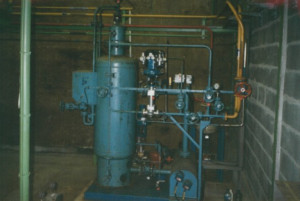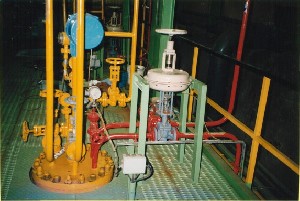A chlorine leak occurred when degassing a sprayer during production downtime at the end of a campaign on a chemical site. The Cl2 tank in use was isolated by 2 remote-controlled valves placed in series ((20) liquid Cl2 tank outlet and (38) pipe shared among the 3 tanks), while the sprayer was connected to the scrubbing tower via a pipe closed by a manual valve (37). The operation began at 8 am; the technician did not sound the alarm before 12:45 pm, when detecting Cl2 in the enclosed 1,800-m³ depot; the site’s automatic alarm network tripped at 1 pm (rate: 2 ppm of Cl2). After closing the 3 valves 20, 37 and 39 (open locked safety valve) 10 min later, the quantity of Cl2 feeding the column had decreased substantially and suction had become more efficient. Nonetheless, in the absence of neutralisation soda, 15 kg of Cl2 (5 kg in the depot + 10 kg in the pipes, sprayer and scrubbing station) were discharged within 5 min as of 1:15 pm through the chimney on the scrubbing tower intended to ensure depot safety. This accident was due to a sequence of defects: inappropriate procedure (degassing routinely performed on a device dedicated to plant safety); design flaws (valve 38 without a sealed seat, no check valves or equipment for controlling soda pH in the tower and Cl2 at the chimney exhaust, impossible to replenish soda supply without turning off the tower); and human errors (valve 20 for feeding Cl2 into the sprayer had remained open during sprayer degassing, operating period lasting well beyond scheduled duration without alarming the technician). The scrubbing tower, designed to neutralise 1,500 kg of Cl2, was saturated; moreover, a foaming of the solution reduced suction efficiency at the column outlet, and gaseous Cl2 stemming from the sprayer was discharged into the storage room. A number of measures were adopted: a defective valve (38) replaced; degassing of devices carried out under normal conditions on one of the chlorination reactors; the scrubbing column kept in safety mode; immediate isolation of valve 37, which would be equipped with a security feature to prevent handling in the case all 4 valves 20 (14 and 26 for the other two tanks) and 38 had not been closed; gradual replacement of valves with flat seats by shear valves; procedural revisions (use of an operational checklist, organisation of emergency response); enhanced technician awareness; and supervision with on-call personnel.
Download the detailed report in .pdf format (113 Kb)






